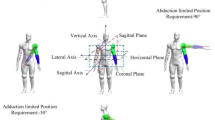Abstract
An exoskeleton robot for shoulder rehabilitation training is designed for patients with hemiplegia due to stroke. In respect of the human upper limb physiology, a series of mechanical structures are integrated: the retractable link meets the upper arm size of different people; the adjustable module relieves the discomfort caused by the scapulohumeral rhythm; and the gravity compensation module ensures patient safety. Then estimate the joint torque and power of the robot to determine the hardware and materials and make the robot prototype. Finally, the robot and PC form a CAN bus communication network and design the robot’s control software based on the ROS (Robot Operating System) platform to realize the basic rehabilitation training of the patient’s shoulder flexion/extension, abduction/adduction and internal/external rotation. Finally, the comfort of the exoskeleton robot is evaluated through the actual experience of healthy people and in the form of a questionnaire. The test results verify the rationality and comfort of the exoskeleton robot to some extent.
Access this chapter
Tax calculation will be finalised at checkout
Purchases are for personal use only
Similar content being viewed by others
References
Marichal, S., Malaisé, A., Modugno, V., Dermy, O., Charpillet, F., Ivaldi, S.: One-shot evaluation of the control interface of a robotic arm by non-experts. In: Agah, A., Cabibihan, J.-J., Howard, A.M., Salichs, M.A., He, H. (eds.) ICSR 2016. LNCS (LNAI), vol. 9979, pp. 458–468. Springer, Cham (2016). https://doi.org/10.1007/978-3-319-47437-3_45
Niyetkaliyev, A.S., Hussain, S., Ghayesh, M.H., Alici, G.: Review on design and control aspects of robotic shoulder rehabilitation orthoses. IEEE Trans. Hum.-Mach. Syst. 47, 1134–1145 (2017)
Hu, W., et al.: A review of upper and lower limb rehabilitation training robot. In: Huang, Y., Wu, H., Liu, H., Yin, Z. (eds.) ICIRA 2017. LNCS (LNAI), vol. 10462, pp. 570–580. Springer, Cham (2017). https://doi.org/10.1007/978-3-319-65289-4_54
Krebs, H., et al.: Robot-aided neurorehabilitation: a robot for wrist rehabilitation. IEEE Trans. Neural Syst. Rehabil. Eng. 15, 327–335 (2007)
Babaiasl, M., Mahdioun, S.H., Jaryani, P., Yazdani, M.: A review of technological and clinical aspects of robot-aided rehabilitation of upper-extremity after stroke. Disabil. Rehabil.: Assist. Technol. 11(4), 263–280 (2016). https://doi.org/10.3109/17483107.2014
Okada, M., Nakamura, Y.: Development of a cybernetic shoulder-a 3-DOF mechanism that imitates biological shoulder motion. IEEE Trans. Robot. 21, 438–444 (2005)
Chen, Y., Li, G., Zhu, Y., Zhao, J., Cai, H.: Design of a 6-DOF upper limb rehabilitation exoskeleton with parallel actuated joints. Bio-Med. Mater. Eng. 24(6), 2527–2535 (2014)
Nef, T., Riener, R., Müri, R., Mosimann, U.P.: Comfort of two shoulder actuation mechanisms for arm therapy exoskeletons: a comparative study in healthy subjects. Med. Biol. Eng. Comput. 51, 781–789 (2013)
Nef, T., Riener, R.: Shoulder actuation mechanisms for arm rehabilitation exoskeletons. In: 2008 2nd IEEE RAS & EMBS International Conference on Biomedical Robotics and Biomechatronics (2008)
Koo, D., Chang, P.H., Sohn, M.K., Shin, J.-H.: Shoulder mechanism design of an exoskeleton robot for stroke patient rehabilitation. In: 2011 IEEE International Conference on Rehabilitation Robotics (2011)
Nef, T., Guidali, M., Riener, R.: ARMin III – arm therapy exoskeleton with an ergonomic shoulder actuation. Appl. Bionics Biomech. 6, 127–142 (2009)
Guo, Y., Ding, G.L., Li, Z.Q.: Development and application of a synchronous belt drive design system. Adv. Mater. Res. 971–973, 450–453 (2014)
Ceccarelli, M., Carbone, G., Cafolla, D., Wang, M.: How to use 3D printing for feasibility check of mechanism design. In: Borangiu, T. (ed.) Advances in Robot Design and Intelligent Control. AISC, vol. 371, pp. 307–315. Springer, Cham (2016). https://doi.org/10.1007/978-3-319-21290-6_31
Xiao, F., Gao, Y., Wang, Y., Zhu, Y., Zhao, J.: Design and evaluation of a 7-DOF cable-driven upper limb exoskeleton. J. Mech. Sci. Technol. 32, 855–864 (2018)
Zhang, Y.X., Zeng, X.Q., Wang, X.J.: Control system design based on CANopen network for multi-legged robot with hand-fused foot. In: Zhao, B., Zhang, Y.D., Wang, G.L., Zhang, H., Zhang, J.B., Jiao, F. (eds.) History of Mechanical Technology and Mechanical Design, vol. 42. Applied Mechanics and Materials, pp. 307–312 (2011)
Hernandez-Mendez, S., et al.: Design and implementation of a robotic arm using ROS and MoveIt! In: 2017 IEEE International Autumn Meeting on Power, Electronics and Computing (ROPEC) (2017)
ROS.org. http://wiki.ros.org/
Xu, G., Song, A., Li, H.: Control system design for an upper-limb rehabilitation robot. Adv. Robot. 25, 229–251 (2011)
Kwakkel, G., Kollen, B.J., Krebs, H.I.: Effects of robot-assisted therapy on upper limb recovery after stroke: A systematic review. Neurorehabil. Neural Repair 22(2), 111–121 (2008). https://doi.org/10.1177/1545968307305457
Acknowledgments
This paper is supported by the Primary Research & Development Program of Jiangsu Province (Grant No. BE2015701), the Natural Science Foundation of Jiangsu Province, China (Grant No. BK20170898, BK20140878), the Opening Project of Southeast University Key Laboratory of Complex Engineering System of Measurement and Control of the Ministry of Education (Grant No. MCCSE2016A06), the Natural Science Foundation of Higher Education Institutions of Jiangsu Province, China (Grant No. 16KJB460017 and No. 17KJD535001), National Natural Science Foundation of China (61603195) and the NUPTSF (Grant No. NY215050 and No. NY218027).
Author information
Authors and Affiliations
Corresponding author
Editor information
Editors and Affiliations
Rights and permissions
Copyright information
© 2018 Springer Nature Switzerland AG
About this paper
Cite this paper
Boheng, W., Sheng, C., Bo, Z., Zhiwei, L., Xiang, G. (2018). Design and Implementation of Shoulder Exoskeleton Robot. In: Ge, S., et al. Social Robotics. ICSR 2018. Lecture Notes in Computer Science(), vol 11357. Springer, Cham. https://doi.org/10.1007/978-3-030-05204-1_24
Download citation
DOI: https://doi.org/10.1007/978-3-030-05204-1_24
Published:
Publisher Name: Springer, Cham
Print ISBN: 978-3-030-05203-4
Online ISBN: 978-3-030-05204-1
eBook Packages: Computer ScienceComputer Science (R0)




